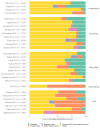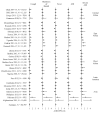Comparison of Respiratory Health Impacts Associated with Wood and Charcoal Biomass Fuels: A Population-Based Analysis of 475,000 Children from 30 Low- and Middle-Income Countries
- PMID: 34501907
- PMCID: PMC8431364
- DOI: 10.3390/ijerph18179305
Comparison of Respiratory Health Impacts Associated with Wood and Charcoal Biomass Fuels: A Population-Based Analysis of 475,000 Children from 30 Low- and Middle-Income Countries
Abstract
Background: The World Health Organisation reported that 45% of global acute respiratory infection (ARI) deaths in children under five years are attributable to household air pollution, which has been recognised to be strongly associated with solid biomass fuel usage in domestic settings. The introduction of legislative restrictions for charcoal production or purchase can result in unintended consequences, such as reversion to more polluting biomass fuels such as wood; which may increase health and environmental harms. However, there remains a paucity of evidence concerning the relative health risks between wood and charcoal. This study compares the risk of respiratory symptoms, ARI, and severe ARI among children aged under five years living in wood and charcoal fuel households across 30 low- and middle-income countries.
Methods: Data from children (N = 475,089) residing in wood or charcoal cooking households were extracted from multiple population-based Demographic and Health Survey databases (DHS) (N = 30 countries). Outcome measures were obtained from a maternal report of respiratory symptoms (cough, shortness of breath and fever) occurring in the two weeks prior to the survey date, generating a composite measure of ARI (cough and shortness of breath) and severe ARI (cough, shortness of breath and fever). Multivariable logistic regression analyses were implemented, with adjustment at individual, household, regional and country level for relevant demographic, social, and health-related confounding factors.
Results: Increased odds ratios of fever (AOR: 1.07; 95% CI: 1.02-1.12) were observed among children living in wood cooking households compared to the use of charcoal. However, no association was observed with shortness of breath (AOR: 1.03; 95% CI: 0.96-1.10), cough (AOR: 0.99; 95% CI: 0.95-1.04), ARI (AOR: 1.03; 95% CI: 0.96-1.11) or severe ARI (AOR: 1.07; 95% CI: 0.99-1.17). Within rural areas, only shortness of breath was observed to be associated with wood cooking (AOR: 1.08; 95% CI: 1.01-1.15). However, an increased odds ratio of ARI was observed in Asian (AOR: 1.25; 95% CI: 1.04-1.51) and East African countries (AOR: 1.11; 95% CI: 1.01-1.22) only.
Conclusion: Our population-based observational data indicates that in Asia and East Africa there is a greater risk of ARI among children aged under 5 years living in wood compared to charcoal cooking households. These findings have major implications for understanding the existing health impacts of wood-based biomass fuel usage and may be of relevance to settings where charcoal fuel restrictions are under consideration.
Keywords: acute respiratory infection; biomass fuel; household air pollution; low-and middle-income countries; respiratory symptoms.
Conflict of interest statement
The authors declare no conflict of interest. The funders had no role in the design of the study; in the collection, analyses, or interpretation of data; in the writing of the manuscript, or in the decision to publish the results.
Figures



Similar articles
-
Investigating the Association between Wood and Charcoal Domestic Cooking, Respiratory Symptoms and Acute Respiratory Infections among Children Aged Under 5 Years in Uganda: A Cross-Sectional Analysis of the 2016 Demographic and Health Survey.Int J Environ Res Public Health. 2020 Jun 4;17(11):3974. doi: 10.3390/ijerph17113974. Int J Environ Res Public Health. 2020. PMID: 32512693 Free PMC article.
-
A Cross-Sectional Analysis of the Association between Domestic Cooking Energy Source Type and Respiratory Infections among Children Aged under Five Years: Evidence from Demographic and Household Surveys in 37 Low-Middle Income Countries.Int J Environ Res Public Health. 2021 Aug 12;18(16):8516. doi: 10.3390/ijerph18168516. Int J Environ Res Public Health. 2021. PMID: 34444264 Free PMC article.
-
Cooking outdoors or with cleaner fuels does not increase malarial risk in children under 5 years: a cross-sectional study of 17 sub-Saharan African countries.Malar J. 2022 Apr 27;21(1):133. doi: 10.1186/s12936-022-04152-3. Malar J. 2022. PMID: 35477567 Free PMC article.
-
Estimated health effects from domestic use of gaseous fuels for cooking and heating in high-income, middle-income, and low-income countries: a systematic review and meta-analyses.Lancet Respir Med. 2024 Apr;12(4):281-293. doi: 10.1016/S2213-2600(23)00427-7. Epub 2024 Feb 1. Lancet Respir Med. 2024. PMID: 38310914
-
Indoor air pollution in developing countries and acute lower respiratory infections in children.Thorax. 2000 Jun;55(6):518-32. doi: 10.1136/thorax.55.6.518. Thorax. 2000. PMID: 10817802 Free PMC article. Review.
Cited by
-
Multidimensional energy poverty and acute respiratory infection in children under 5 years of age: evidence from 22 low-income and middle-income countries.J Epidemiol Community Health. 2023 Nov;77(11):687-693. doi: 10.1136/jech-2023-220540. Epub 2023 Aug 24. J Epidemiol Community Health. 2023. PMID: 37620007 Free PMC article.
-
Household Microenvironment and Under-Fives Health Outcomes in Uganda: Focusing on Multidimensional Energy Poverty and Women Empowerment Indices.Int J Environ Res Public Health. 2022 May 30;19(11):6684. doi: 10.3390/ijerph19116684. Int J Environ Res Public Health. 2022. PMID: 35682268 Free PMC article.
-
Health risks associated with the production and usage of charcoal: a systematic review.BMJ Open. 2023 Jul 24;13(7):e065914. doi: 10.1136/bmjopen-2022-065914. BMJ Open. 2023. PMID: 37487686 Free PMC article.
-
Association of household air pollution with cellular and humoral immune responses among women in rural Bangladesh.Environ Pollut. 2022 Apr 15;299:118892. doi: 10.1016/j.envpol.2022.118892. Epub 2022 Jan 22. Environ Pollut. 2022. PMID: 35077836 Free PMC article.
-
Magnitude and factors associated with post-tuberculosis lung disease in low- and middle-income countries: A systematic review and meta-analysis.PLOS Glob Public Health. 2022 Dec 20;2(12):e0000805. doi: 10.1371/journal.pgph.0000805. eCollection 2022. PLOS Glob Public Health. 2022. PMID: 36962784 Free PMC article.
References
-
- Cohen A.J., Brauer M., Burnett R., Anderson H.R., Frostad J., Estep K., Balakrishnan K., Brunekreef B., Dandona L., Dandona R., et al. Estimates and 25-year trends of the global burden of disease attributable to ambient air pollution: An analysis of data from the Global Burden of Diseases Study 2015. Lancet. 2017;389:1907–1918. doi: 10.1016/S0140-6736(17)30505-6. - DOI - PMC - PubMed
-
- Smith K., Bruce N., Balakrishnan K., Adair-Rohani H., Balmes J., Chafe Z., Dherani M., Hosgood H.D., Mehta S., Pope D., et al. Millions dead: How do we know and what does it mean? Methods used in the comparative risk assessment of household air pollution. Annu. Rev. Public Health. 2014;35:185–206. doi: 10.1146/annurev-publhealth-032013-182356. - DOI - PubMed
-
- Gordon S.B., Bruce N.G., Grigg J., Hibberd P.L., Kurmi O.P., Lam K.H., Mortimer K., Asante K.P., Balakrishnan K., Balmes J., et al. Respiratory risks from household air pollution in low and middle income countries. Lancet Respir. Med. 2014;2:823–860. doi: 10.1016/S2213-2600(14)70168-7. - DOI - PMC - PubMed
-
- Tielsch J.M., Katz J., Thulasiraj R.D., Coles C.L., Sheeladevi S., Yanik E.L., Rahmathullah L. Exposure to indoor biomass fuel and tobacco smoke and risk of adverse reproductive outcomes, mortality, respiratory morbidity and growth among newborn infants in south India. Int. J. Epidemiol. 2009;38:1351–1363. doi: 10.1093/ije/dyp286. - DOI - PubMed
Publication types
MeSH terms
Substances
LinkOut - more resources
Full Text Sources
Medical

